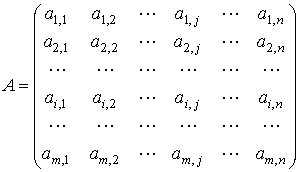|
A matrix
is a rectangular array of numbers, algebraic symbols, or mathematical
functions, provided that such arrays are added and multiplied according
to certain rules.
|
Matrices are denoted by upper case letters such as A, B, C, ...
A matrix with m rows and n columns is called an m x n matrix (pronounce m-by-n matrix).
| Examples |
|
|
|
|
|
|
|
|
The element on the i-th row and j-th column of a matrix A is denoted by ai,j. The subscripts indicate the row first and the column second.
A matrix in the general form is written as follows:

A short form of this equality is
![]() .
.
The size of the matrix is given by the number of rows and the number of columns.
If both matrices, A and B, are m x n matrices, then they have the same size.
A matrix with one row is called a row matrix.
For instance, the following one-by-three column matrix
![]()
is a row matrix.
A matrix with one column is called a column matrix:

A matrix is called a square matrix if the number of its rows equals the number of the columns.
A square matrix of n-th order is a n x n matrix.
In a square matrix the elements ai,i, with i = 1, 2, 3, ..., are called diagonal matrix elements.
A matrix is called a diagonal matrix if all its off-diagonal elements are equal to zero, but at least one of the diagonal elements is nonzero:
![]()
| Examples |
1. The diagonal of the following square matrix of the third order

consists of numbers 4, 5, and 9, which are diagonal elements.
2. The matrix

is a diagonal matrix of the third order.
An identity matrix is a diagonal matrix whose diagonal elements are equal to unity.
Usually, identity matrices are denoted by the symbol
I. The matrix elements of an identity
matrix I are denoted by the symbol ![]() which is known as the
Kronecker delta symbol.
which is known as the
Kronecker delta symbol.
Thus,
![]() ,
,
where

The delta symbol cancels symmation over one of the symbols in such expressions as

Each of the above sum contains only one nonzero item, e.g.,
![]() .
.
All the rest entries are equal to zero, since ![]() for any
for any ![]() .
.
For instance, if j = 3
then ![]() , while
, while ![]() , and so
, and so
![]() .
.
| Examples |
|
Identity matrix of the second order |
Identity matrix of the third order |
|
|
|
The diagonal subdivides a square matrix into two blocks, one above the diagonal and the other one below it. The matrix has a triangular form, if one of the blocks consists of zeros:
all ai,j=0 for i>j or for i<j
| Examples |
|
Upper-triangular matrix |
Lower-triangular matrix |
|
|
|
Given a ![]() matrix
matrix ![]() , the transpose
of A
is the
, the transpose
of A
is the ![]() matrix
matrix ![]() obtained from A
by interchanging its rows and columns. This means that the rows of a matrix
A are the columns of the matrix
obtained from A
by interchanging its rows and columns. This means that the rows of a matrix
A are the columns of the matrix ![]() ; and vise
versa:
; and vise
versa:
![]() .
.
| Example |
If  then
then  .
.
A square matrix ![]() is called symmetric
if
is called symmetric
if
![]() .
.
| Example |
The following matrix

is a symmetric matrix, since ![]() .
.
A square matrix is called skew-symmetric if
![]()
A matrix is called a zero-matrix (or 0-matrix) if all its elements are equal to zero, that is,
![]()
for each pair of indexes {i, j}.
In a short form 0-matrix is written as 0.






